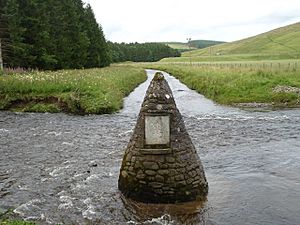River Esk, Dumfries and Galloway facts for kids
The River Esk, also called the Border Esk, is a river that starts in Scotland. It flows through a part of Scotland called Dumfries and Galloway. Then, it crosses into England, entering the county of Cumbria. Finally, the river empties into the Solway Firth, which is a large bay.
Contents
Where Does the River Esk Start and Go?
The River's Journey from Hills to the Sea
The River Esk begins high up in the hills. These hills are located to the east of a town called Moffat in Scotland. As it flows, the river gets bigger. This happens when two important smaller rivers, the Black Esk and the White Esk, join together. They meet at the southern edge of a place called Castle O'er Forest.
After this, the River Esk flows southeast through a valley known as Eskdale. It passes by the town of Langholm. Near Langholm, you can see the Duchess Bridge. This bridge is very old and is thought to be the oldest iron bridge in all of Scotland!
Crossing the Border and Meeting Other Rivers
Further along, the Esk joins with another river called Liddel Water. This Liddel Water actually marks part of the border between Scotland and England. Soon after, the River Esk officially enters England.
Before reaching the town of Longtown, the Esk meets the River Lyne. Finally, the River Esk flows into the Solway Firth. It enters the Firth close to where the River Eden also flows in.
A Historical Boundary
Long ago, the River Esk was an important boundary. It helped mark the edge of an area known as the Debatable Lands. This area was often argued over between Scotland and England. The Scots' Dike was a special ditch that also helped mark this boundary.
What Rivers Join the Esk?
The White Esk and Black Esk
The White Esk is one of the main rivers that forms the River Esk. It starts when two smaller streams, the Glendearg and Tomleuchar burns, combine. It then flows south through Eskdalemuir Forest. Along the way, it collects water from the Garwald Water. The White Esk continues past the village of Eskdalemuir and into Castle O'er Forest. A road, the B709, follows much of its path.
The Black Esk is the other main river that forms the River Esk. Its waters first fill the Black Esk Reservoir. From the bottom of the dam, the Black Esk flows south. It passes under the B723 road at Sandyford. Then, it turns sharply east and southeast. It flows past Castle O'er before finally meeting the White Esk. When they meet, they form the larger River Esk.
Other Rivers Joining the Esk
- Meggat Water: This river flows into the Esk from the left side. It starts at the southern edge of Craik Forest and flows south. It is joined by the Stennies Water before it meets the Esk.
- Ewes Water: This is a big river that joins the Esk at Langholm. Its headwaters (the very beginning streams) are the Eweslees, Mosspaul, and Carewoodrig Burns. These streams combine to form the Ewes Water, which flows south. Many other streams join it, including the Meikledale Burn. The A7 road and an electricity line follow the valley of the Ewes Water.
- Wauchope Water: This river joins the Esk from the right side, just after the Ewes Water. It starts when the Logan Water and Bigholms Burn meet about 3 miles (5 km) southwest of Langholm.
- Tarras Water: This river joins the Esk from the left side. It meets the Esk about 2.5 miles (4 km) south of Langholm.
Rivers Near the Mouth of the Esk
- Liddel Water: This is a very important river that joins the Esk from the left side. It flows between Canonbie and Longtown. For a while, the Liddel Water forms the border between Scotland and England. Its own tributary, the Kershope Burn, also helps define this border.
- River Lyne: This river enters the Esk from the left side at a place called Lynefoot. This is just above where the Esk becomes tidal, meaning the ocean's tides start to affect its water level.
- River Sark and Kirtle Water: These two rivers flow into the tidal part of the Esk estuary. The River Sark joins to the east of Gretna, and the Kirtle Water joins to the west of Gretna.



